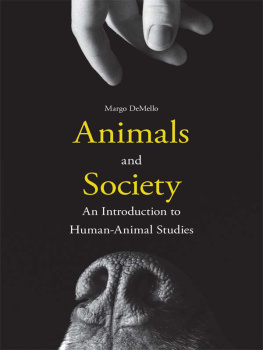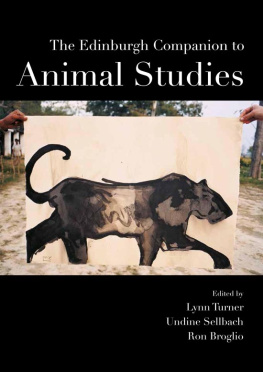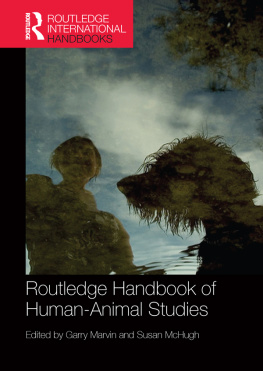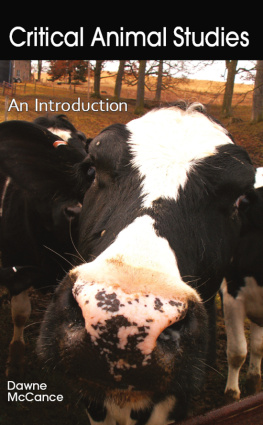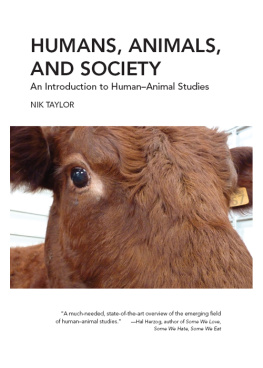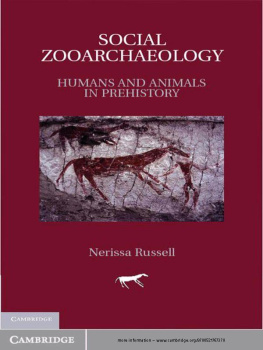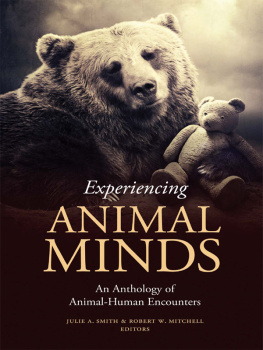DeMello - Animals and society: an introduction to human-animal studies
Here you can read online DeMello - Animals and society: an introduction to human-animal studies full text of the book (entire story) in english for free. Download pdf and epub, get meaning, cover and reviews about this ebook. City: New York, year: 2012, publisher: Columbia University Press, genre: Romance novel. Description of the work, (preface) as well as reviews are available. Best literature library LitArk.com created for fans of good reading and offers a wide selection of genres:
Romance novel
Science fiction
Adventure
Detective
Science
History
Home and family
Prose
Art
Politics
Computer
Non-fiction
Religion
Business
Children
Humor
Choose a favorite category and find really read worthwhile books. Enjoy immersion in the world of imagination, feel the emotions of the characters or learn something new for yourself, make an fascinating discovery.
- Book:Animals and society: an introduction to human-animal studies
- Author:
- Publisher:Columbia University Press
- Genre:
- Year:2012
- City:New York
- Rating:3 / 5
- Favourites:Add to favourites
- Your mark:
- 60
- 1
- 2
- 3
- 4
- 5
Animals and society: an introduction to human-animal studies: summary, description and annotation
We offer to read an annotation, description, summary or preface (depends on what the author of the book "Animals and society: an introduction to human-animal studies" wrote himself). If you haven't found the necessary information about the book — write in the comments, we will try to find it.
DeMello: author's other books
Who wrote Animals and society: an introduction to human-animal studies? Find out the surname, the name of the author of the book and a list of all author's works by series.
Animals and society: an introduction to human-animal studies — read online for free the complete book (whole text) full work
Below is the text of the book, divided by pages. System saving the place of the last page read, allows you to conveniently read the book "Animals and society: an introduction to human-animal studies" online for free, without having to search again every time where you left off. Put a bookmark, and you can go to the page where you finished reading at any time.
Font size:
Interval:
Bookmark:
Animals and Society

ANIMALS AND SOCIETY
An Introduction to Human-Animal Studies
Margo DeMello
COLUMBIA UNIVERSITY PRESS  NEW YORK
NEW YORK


Columbia University Press
Publishers Since 1893
New York Chichester, West Sussex
cup.columbia.edu
Copyright 2012 Columbia University Press
All rights reserved
E-ISBN 978-0-231-52676-0
COVER IMAGES: istockphoto / Photos by Jason Ruis (top) and Jeff Chevrier (bottom)
COVER DESIGN: Martin Hinze
Library of Congress Cataloging-in-Publication Data
DeMello, Margo.
Animals and society: an introduction to human-animal studies / Margo DeMello.
p. cm.
Includes bibliographical references and index.
ISBN 978-0-231-15294-5 (cloth : alk. paper)ISBN 978-0-231-15295-2 (pbk. : alk. paper)
ISBN 978-0-231-52676-0 (ebook)
1. Human-animal relationships. 2. Human-animal relationshipsHistory. 3. Animals and civilizationHistory. I. Title.
QL85.D48 2012
599.15dc23
2012013347
A Columbia University Press E-book.
CUP would be pleased to hear about your reading experience with this e-book at .
References to Internet Web sites (URLs) were accurate at the time of writing. Neither the author nor Columbia University Press is responsible for URLs that may have expired or changed since the manuscript was prepared.
Contents
While I have wanted to write a human-animal studies (HAS) textbook for yearssince the first time I taught an HAS class in 2003the drive to complete this book came from my work with the Animals and Society Institute (ASI), and my role on the Human-Animal Studies Executive Committee. In October 2004, a group of fifteen scholars working in the field of HAS first came together in conjunction with the International Compassionate Living Festival to discuss this rapidly growing field, and our roles in it. At that first meeting, we strategized about the further development of HAS and how we could help to enhance the presence of this newly developing discipline in academic institutions across the country.
Since that meeting, our committee, now made up of myself, Ken Shapiro (ASI), Carrie Rohman (Lafayette College), Cheryl Joseph (Notre Dame de Namur University), Christina Risley-Curtiss (Arizona State University), Kathie Jenni (University of Redlands), Paul Waldau (Religion and Animals Institute), Georgina Montgomery (Michigan State University), and Robert Mitchell (Eastern Kentucky University), has gone on to create the Human-Animal Studies Fellowship program, an annual fellowship that brings together scholars in HAS for a six-week intensive period each summer, now held in conjunction with Wesleyan University. We also wrote an edited collection, Teaching the Animal: Human-Animal Studies Across the Disciplines (Lantern 2010), that includes concrete information on teaching HAS in a variety of natural science, social science, and humanities courses.
In the few years since we have been meeting, we have seen the field of human-animal studies grow by leaps and bounds. There are now more courses offered at more colleges and universities than ever before, more conferences devoted to HAS, more college programs, institutes, journals, list serves, veterinary programs, legal centers, and organizations. Clearly, interest in HAS is exploding. But one thing the discipline still needed was a textbook for college students.
This book is intended to fill the gap in the field by giving professors a comprehensive overview of the field, and by giving students an easy-to-read text covering many of the issues related to the question of animals in human society. I also hope that the existence of this text will encourage more professors to develop new courses that focus on the human-animal relationship. But I especially hope that readersboth students and instructorswill recognize that there is an important place within the college curriculum for looking at animals, their relationship with humans, and the very real implications of those relationships.
Cultural studies critic Cary Wolfe recently wrote that trying to give an overview of the burgeoning area known as animal studies is, if youll permit me the expression, a bit like herding cats (2009: 564). Herding cats, indeed!
Without the aid of numerous people and organizations, this textbook could not have been written. I owe thanks to more people than I can possibly mention, but will here thank those who most directly helped me to get this book off the ground. First, I have to acknowledge the Human-Animal Studies Committeewithout its establishment, I would not even have gotten involved in the field. The Human-Animal Studies Committee would not have itself gotten established without the support of the Animals and Society Institute (ASI), a research and educational organization that advances the status of animals in public policy and promotes the study of human-animal relationships. I owe my deepest thanks to my fellow committee members for inspiring me with their own work, but especially to Ken Shapiro, ASIs executive director, for his support for this project. All proceeds raised from the sale of this textbook will, in fact, be donated to ASI to support the organizations important work. In fact, if it werent for meeting Ken at an animal rights conference in 2002, I would not have known about the existence of human-animal studies, and most likely would not have returned to teaching after having left the field a few years earlier. If it werent for Ken, my life would be very different today.
I am also thankful to Wendy Lochner at Columbia University Press for expressing an interest in this book, and for her work expanding Columbias Animal Studies series. I first began shopping this book around in 2005, and was told by each publisher I approached that the market was too small to support such a text. Wendy recognized both the importance of, and growth of, the field of HAS and knew that with the growth of HAS there would indeed be an audience for this book. Through Wendy, six anonymous readers provided feedback on this manuscript and I am grateful to all of them. I am especially grateful to philosopher Ralph Acampora, whose comments on were invaluable in improving that chapter.
I am also grateful to the following colleagues and friends for providing essays on their own work that are included in these chapters. Thanks to Susan McHugh, Annie Potts, Walter Putnam, Molly Mullin, Garry Marvin, Cheryl Joseph, Cynthia Kay Chandler, Clinton Sanders, Ken Shapiro, David Nibert, Carol Gigliotti, Laura Hobgood-Oster, Philip Armstrong, Robert W. Mitchell, and Kathie Jenni for generously contributing in this way.
I want to thank as well everyone who provided photos for this book. That includes Anita Carswell, Annette Evangelista, Carol Adams, Christine Morrissey of Harvest Home Animal Sanctuary, Criss Starr of New Mexico House Rabbit Society, Dr. Carolynn Harvey, Drew Trujillo, Ed Turlington, Ed Urbanski and Yvonne Boudreaux of Prairie Dog Pals, Elizabeth Terrien, Great Ape Trust, Jonnie Russell, Karen Diane Knowles, Kate Turlington, Kerrie Bushway, Lynley Shimat Lys, Mark Dion through the Tanya Bonakdar Gallery, Mary Cotter, Mercy for Animals, People for the Ethical Treatment of Animals, Robin and Christopher Montgomery, Suzi Hibbard, The Jane Goodall Institute, Thomas Cole, Tracy Martin, Vicki DeMello, and Yvette Watt. I am also grateful to the many photographers who contributed their work for free to Wikimedia Commons; many of the images in this book came from that site. I especially want to extend my appreciation to Dan Piraro, creator of the syndicated comic strip
Next pageFont size:
Interval:
Bookmark:
Similar books «Animals and society: an introduction to human-animal studies»
Look at similar books to Animals and society: an introduction to human-animal studies. We have selected literature similar in name and meaning in the hope of providing readers with more options to find new, interesting, not yet read works.
Discussion, reviews of the book Animals and society: an introduction to human-animal studies and just readers' own opinions. Leave your comments, write what you think about the work, its meaning or the main characters. Specify what exactly you liked and what you didn't like, and why you think so.

